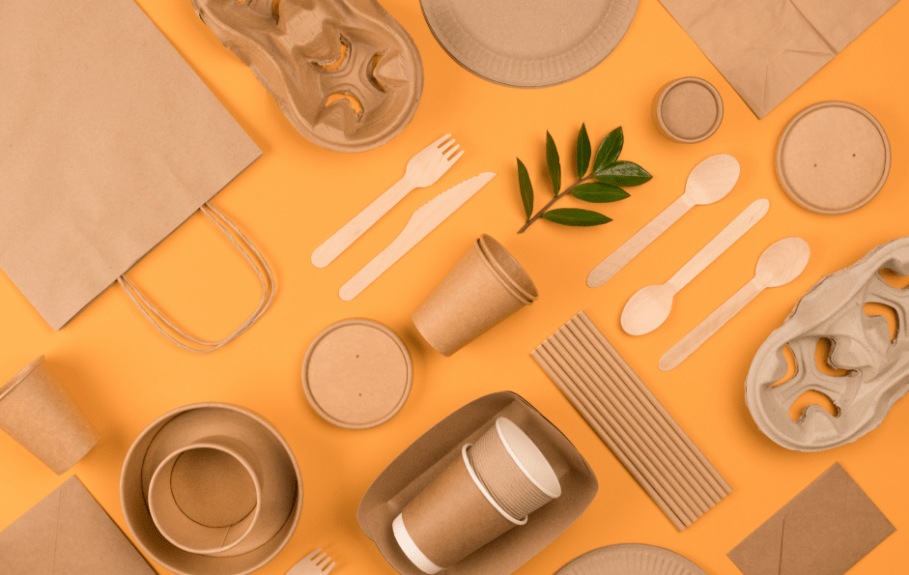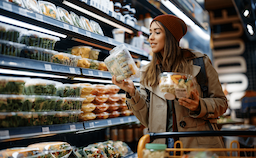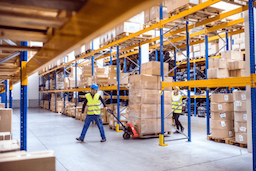March 7, 2022
Good Things Come In Sustainable Packaging

In 2019, India produced 660 lakh tons of plastic waste. Nearly 43% of this, roughly 280 lakh tons, is packaging waste. Most of this is single-use plastic. Let that number sink in.
There has been a seismic shift in customer behavior, demand for goods, and a multitude of supply chain disruptions in the past two years. The COVID19 pandemic has changed the way we consider purchase decisions and accelerated a shift to digital buying for the large swathe of middle-class India. The Indian Institute of Packaging (IIP) estimates that the packaging consumption in India has increased by more than 200% – from 4.3 kg per person per annum to 8.6 kg pppa.
Paper is a more sustainable option than single-use plastic. Industry figures indicate that more than 49% of all paper produced in India is used for packaging. Given the global demand for craft paper in markets like China and the US leading procurement demand, India and other emerging economies are feeling the pricing pinch.
India’s COP26 Commitments and Compliance Framework for Sustainable Packaging
The Glasgow Climate Pact has clearly demarcated two important considerations. Net-zero emissions are the obvious first. However, the path to get there will be customized to ground realities. India finds itself at a critical reboot stage with regards to the transition map for governments, large enterprises, and MSMEs to hit the ground running with digital transformation.
The Cost of Climate Change Report spells out a dire implication of climate change. It is estimated that 3-10% of our GDP will be compromised by 2100 while increasing average poverty rates by 3%. If we are to achieve a target of becoming a $5 trillion economy by 2030, we will have to achieve a real GDP growth rate of 12.5% and create 90 million jobs in the non-farm sectors. Integral to the roadmap for achieving this vision is the substitution of existing high carbon content packaging materials, suppliers, and processes with more sustainable packaging materials, suppliers with such manufacturing capability, and demand aggregation in the end-to-end packaging supply chain.
The Plastic Waste Management Amendment Rules, 2021, announced in August by the Union Ministry of Environment, Forest and Climate Change (MoEFCC), identified that 20 identified SUPs will be phased out by next year. These are generally classified as lowest utility and highest environmental impact. In India, 18 states have already implemented a complete SUP ban, but the upcoming July milestone will extend the legislation across the country. The shift to more sustainable packaging material will be swift, and manufacturers need to display vision and plan to ensure they are not plagued by supply chain disruptions in the transition process.
The Search for Sustainable Packaging Material Substitutes Begins:
The government’s push for the compulsory use of plastics of a minimum of 75-micron thickness from December 2021 and a minimum of 120-micron plastics from July 2022 will generate demand for sustainable packaging and drive investments in these new products categories. The packaging product categories that are likely to increase demand are seaweed, organic fabrics, corn starch, wood, paperboard, recycled cardboard, and paper.
It is time for the Indian packaging ecosystem to move away from a siloed approach. Technology adoption is the need of the hour, not only for building better packaging material but also for the digital transformation of the packaging supply chain. Technology adoption in packaging materials can facilitate capacity expansion, bring economies of scale, and reduce unit costs. On the other hand, collaborative data sharing among the stakeholders in the supply chain can get greater visibility into demand and supply mapping across locations in India, pricing, and agile distribution.
The demand for single substrate packaging alternatives is set to soar. The cost and environmental benefits would be tremendous if we could bring that down to a single layer of substrate packaging. Consider an example of an FMCG manufacturer who currently uses three layered packaging materials: BOPT, LDPE, and a metal pack. Here are some examples of alternative materials that could play a significant role in the packaging industry in the next few years:
Bio-based Plastics – Bio-based plastics typically use food crops such as corn and sugarcane, both available in surplus in the country.
Polylactic acid (PLA) – Transparent solid polymer that is similar to PETE polymer but has a significantly lower maximum continuous use temperature
Poly hydroxyalkanoate (PHA) – is a much more eco-friendly polymer that can handle high temperatures and decompose in soil and waterways. Both alternatives are made from fermented corn sugar, and they can decompose up to 90% within 90 days if disposed of properly.
Paper-based packaging – Corrugated box and other forms of paper-based packaging are biodegradable if it does end up in landfill, can be easily recycled by end-users, and the raw material is carefully managed (basically planting more trees)
Edible packaging – Natural polymers in food packaging, like Algae, seaweeds, polysaccharides, proteins, lipids, or composites.
Bridging the Packaging Supply Chain Digital Divide
Plastics account for nearly a third of carbon emissions in core manufacturing verticals like metals, mining, and construction materials. Next in the pecking order of importance are energy, agriculture, allied activities, logistics, and HVAC, which represent the highest contributors. FMCG, consumer appliances, e-commerce, hospitality, and F&B also add their fair share of environmental footprint.
The answer to standardization of data sharing on carbon emissions compared to alternatives across a cross-section of manufacturers, MSME suppliers, logistics, and warehouse partners is undoubtedly a digital platform that can account for industry and process variations.
Unfortunately, digital integration in India’s supply chain is at less than 5%, obscuring visibility into carbon emissions at each stage of the supply chain. Due to the lack of this visibility, brands and manufacturers find it challenging to identify partners for on-demand sustainable transition who have the manufacturing capacity to scale with them.
Simply put, the easiest path to sustainability is through measurement. By analyzing data on carbon emissions and viable alternatives, all stakeholders can make responsible choices to bring transformative change quickly, at optimum costs, and without friction in the current packaging value chain.
How Can Brands Play a More Prominent Role?
Product packaging plays a prominent role in the purchase decision of the consumer. Primary packaging makes all the difference to the customer’s first impression and the brand recall later. Take the case of the food and beverage industry – chocolates, soft drinks, processed foods, packaged whole grains, and cereals, for instance, are packaged using laminates. The pandemic has changed consumer perception around packaging as well.
Brands need to put technology at the center of their transformation, create robust governance models to govern operations, and collaborate with a broader ecosystem to make a significant impact footprint. The surge in deliveries, wastage of packaging, and a growing consciousness of the digital consumer will force brands to consider sustainable packaging options carefully. Most studies indicate that consumers also evaluate brand packaging on their green footprint and low-touch point processes (the lesser, the better).
Here are the most important reasons why brands should strongly consider transforming their packaging usage:
- Be the ‘right’ brand – Consumers prefer brands with more sustainable packaging than their competitors.
- Talent retention – By doing the ‘right thing,’ brands build the perception of being a responsible producer, which affects employees’ morale and loyalty.
- Reduction of carbon footprint and costs – extends to the financial and social responsibility aspect advantages, which are measurable.
- Investment opportunities – the world is veering towards investing responsibly, and larger AUMs focus on brands adhering to ESG norms.
While this builds a strong brand image, the path to packaging material and supply chain transformation is complicated and needs an end-to-end advisor who can envision upstream and downstream requirements, mitigate risks and provide solutions platforms that enable seamless migration. At Moglix, we work with more than 700 manufacturers, 16000 suppliers, 40 logistics partners, and 30 warehouses into a single ecosystem for 6000 packaging SKUs spread across 45 categories to create an unmatched collaboration ecosystem for all stakeholders.
What will Drive Sustainability in Packaging?
Like us, all stakeholders in the packaging supply chain ecosystem are acutely aware of the implications of a collective failure to adopt more sustainable best practices. By reducing the compliance costs with the amendments to the Plastic Waste Management Rules, 2021, we enable large enterprises to hit the ground running with agility.
Industry leaders should aspire to create a brand of impact by revamping and reimagining product packaging and supply chain processes with technology at the core. A seamless transition, however, requires much planning. The brand perception, economic and environmental costs are too significant for companies to take lightly.
The pandemic, coupled with the COP26 commitments for a greener future and government legislation to eliminate single-use plastic, should be viewed as a golden opportunity to hit the reset button. By placing digital technology solutions, material innovation, and process optimization at the core for a better tomorrow, the government, corporations, and the supplier ecosystem can usher in a new age of conscious commerce. That is why it is time to say that good thing come in sustainable packages.
Moglix Sustainable Packaging Supply Chain Solutions
We are Moglix; India’s largest packaging solutions provider. From reducing costs, enhancing branding, and meeting sustainability goals, we enable enterprises to reimagine their packaging supply chain by integrating economic and technical efficiencies in one metric: sustainability. To learn how you can leverage Moglix sustainable packaging solutions, please reach out to us at info@moglixbusiness.com



